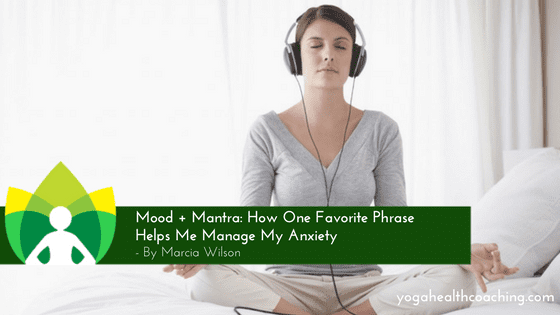
Mood + Mantra: How One Favorite Phrase Helps Me Manage My Anxiety
“Breathing in, I calm my body and mind. Breathing out, I smile. Dwelling in the present moment I know this is the only moment.”
― Thich Nhat Hanh– from Being Peace
When I was 25 my dad died from pancreatic cancer. His death, just 4 months after diagnosis, left me questioning what it meant to live a full life and how we can most effectively navigate these very human challenges. My search for answers unfolded into studies in Buddhism, Yoga, and eventually Ayurveda. Some of the first writings I was introduced to were the simple and effective teachings of Buddhist monk, Thich Nhat Hanh. One of my favorite writings of Thich Nhat Hanh was a mantra from his book, Being Peace: “Breathing in, I calm body and mind. Breathing out, I smile. Dwelling in the present moment, I know this is the only moment.” This phrase was taught to me in an abbreviated form: “calm, smile, present, wonderful.” I began to use it during hot and sweaty Bikram yoga classes, during the stress of marital separation and as a tool to share with my yoga students. Over 20 years later this mantra is still my favorite go-to.
Mantra = Mind Protecting
Mantra- the use of sounds or words as objects of concentration- means “mind protecting. ” By allowing our awareness to settle on the sounds we repeat aloud or silently we “protect” ourselves from thoughts or emotional responses triggered by our daily lives. Staying focused on the mantra protects us from negative thoughts, monkey mind and replaying conversations in our head. It keeps us in the moment. Mantra comes in many forms. Some mantras, called “seed” mantras, are sounds that do not have a particular meaning in English. Full phrases in both Sanskrit, “om shanti shanti shanti,” and English (“breath in goes deep, breath out goes slow”) are used commonly. Mantras can be used with other practices like yoga or as a stand alone meditation practice.
Train Your Nervous System to Be Calm and Steady
A key teaching from the world of Ayurveda is the value of mindfulness or meditation practice as part of a daily rhythm of self care called “dinya charya”. One of my teachers- the Abbot of a Theravada Buddhist Monastery, helped me understand that practice is just that, practice. The time we spend meditating – whether we follow the breath or use a mantra- gives our nervous system and subconscious a chance to develop a familiarity with the technique. The goal? When we face a challenge in real life – when we need to be calm and steady and hold space for ourselves – the mantra and our breath are right there with us. Our practice gives us ability to access calm and peace even when it seems elusive.
Anxiety + Overwhelm: Using Mantra to Navigate Life
As much as I had used the mantra “calm, smile” both in practice and in troubled times, it was this winter, over 20 years after first learning it – that I had the chance to see the full benefit of mantra in action.
My History of Anxiety
Part of my history is one of anxiety and overwhelm. I notice that this tendency is worsening as I age. Ayurveda views anxiety through the lens of what is called a Vata overdominance imbalance. As we age, we tend to become even more Vata dominant in our bodies, minds, and hearts which means that managing anxiety is made easier by self care practices like keeping things simple, following a routine, oil massage, and using practices like yoga and meditation. Although I follow Vata pacifying self care practices, my life recently has been one of travel, living in temporary accommodations and spending endless hours working on the computer. These are all lifestyle factors that increase Vata and make me more vulnerable to the panic attacks I can experience on planes and buses when I feel confined.
How I Stopped My Panic Attack
I am sitting in an aisle seat in a plane. I fly a lot and love travelling in spite of the fact that as soon as the beverage cart rolls up beside me and the flight attendant looks down at me, I get triggered. Something about this scenario makes me unbelievably claustrophobic, which I compensate for first by taking off shoes and sweaters. I start clearing away anything that might be blocking me or even touching me. I ask my family to move as far into their seat as they can. The stronger my panic attack the more I need to take action, I ask the flight attendant to move the cart, and I often stand up and try to walking in the aisle. In the past, I have never been able to calm myself without asking others to help by moving and giving me space. On my recent flight to Mexico, I had a surprise. I began to feel myself getting triggered, a panic attack looked inevitable, I looked down, dug deep, and began repeating “breathing in, I calm my body, breathing out, I smile.” I blocked out everything else and repeated until the beverage cart moved on. And to my surprise, I averted my panic attack.
Trust The Practice
I lie on the floor in Bikram yoga with eyes wide open, breath ragged and “calm, smile, present, wonderful” on endless repeat. Walking and breathing to the rhythm of mantra. Meditation. Following my breath, as I drive, sit to work and in-between activities.I have learned that practice comes in many forms and that when my real-life anxiety meets years of experience with a favorite mantra, my ability to calm and regroup is right there, waiting for me. Breathing in, I calm my body. Breathing out, I smile. I got this.



